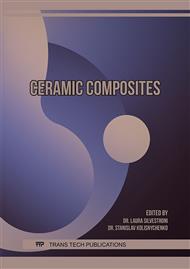[1]
S.Q. Guo, Y. Kagawa, T. Nishimura, Mechanical behavior of two-step hot-pressed ZrB2-based composites with ZrSi2, Journal of the European Ceramic Society. 29 (4) (2009) 787-794.
DOI: 10.1016/j.jeurceramsoc.2008.06.037
Google Scholar
[2]
M. Shahedi Asl, F. Golmohammadi, M. Ghassemi Kakroudi, M. Shokouhimehr, Synergetic effects of SiC and Csf in ZrB2-based ceramic composites. Part I: Densification behavior, Ceramics International. 42 (3) (2016) 4498-4506.
DOI: 10.1016/j.ceramint.2015.11.139
Google Scholar
[3]
F. Monteverde, A. Bellosi, L. Scatteia, Processing and properties of ultra-high temperature ceramics for space applications, Materials Science and Engineering: A. 485 (1–2) (2008) 415-421.
DOI: 10.1016/j.msea.2007.08.054
Google Scholar
[4]
J.J. Sha, Z.Q. Wei, J. Li, Z.F. Zhang, X.L. Yang, Y.C. Zhang, J.X. Dai, Mechanical properties and toughening mechanism of WC-doped ZrB2–ZrSi2 ceramic composites by hot pressing, Materials & Design. 62 (2014) 199-204.
DOI: 10.1016/j.matdes.2014.04.083
Google Scholar
[5]
D. Sciti, F. Monteverde, S. Guicciardi, G. Pezzotti, A. Bellosi, Microstructure and mechanical properties of ZrB2–MoSi2 ceramic composites produced by different sintering techniques, Materials Science and Engineering: A. 434 (1–2) (2006) 303-309.
DOI: 10.1016/j.msea.2006.06.112
Google Scholar
[6]
J.J. Sha, J. Li, S.H. Wang, Y.C. Wang, Z.F. Zhang, J.X. Dai, Toughening effect of short carbon fibers in the ZrB2–ZrSi2 ceramic composites, Materials & Design. 75 (2015) 160-165.
DOI: 10.1016/j.matdes.2015.03.006
Google Scholar
[7]
L. Silvestroni, S. Guicciardi, M. Nygren, C. Melandri, D. Sciti, Effect of the sintering additive on microstructure and mechanical properties of Hi-nicalon™ SiC fibers in a HfB2 matrix, Journal of the American Ceramic Society. 96 (2) (2013).
DOI: 10.1111/jace.12018
Google Scholar
[8]
J.S. Li, C.R. Zhang, B. Li, Preparation and characterization of boron nitride coatings on carbon fibers from borazine by chemical vapor deposition, Applied Surface Science. 257 (17) (2011) 7752-7757.
DOI: 10.1016/j.apsusc.2011.04.024
Google Scholar
[9]
L. Zhang, C. Ren, C. Zhou, H. Xu, X. Jin, Single fiber push-out characterization of interfacial mechanical properties in unidirectional CVI-C/SiC composites by the nano-indentation technique, Applied Surface Science. 357, Part B (2015) 1427-1433.
DOI: 10.1016/j.apsusc.2015.10.018
Google Scholar
[10]
W.M. Mueller, J. Moosburger-Will, M.G.R. Sause, M. Greisel, S. Horn, Quantification of crack area in ceramic matrix composites at single-fiber push-out testing and influence of pyrocarbon fiber coating thickness on interfacial fracture toughness, Journal of the European Ceramic Society. 35 (11) (2015).
DOI: 10.1016/j.jeurceramsoc.2015.04.033
Google Scholar
[11]
Y. Zu, J. Sha, J. Li, Z. Zhang, S. Wang, Z. Lv, J. Dai, Effect of multi-walled carbon nanotubes on microstructure and fracture properties of carbon fiber-reinforced ZrB2-based ceramic composite, Ceramics International. 43 (10) (2017) 7454-7460.
DOI: 10.1016/j.ceramint.2017.03.018
Google Scholar
[12]
J.J. Sha, J. Li, S.H. Wang, Z.F. Zhang, Y.F. Zu, S. Flauder, W. Krenkel, Improved microstructure and fracture properties of short carbon fiber-toughened ZrB2-based UHTC composites via colloidal process, International Journal of Refractory Metals and Hard Materials. 60 (2016).
DOI: 10.1016/j.ijrmhm.2016.07.010
Google Scholar
[13]
L. Silvestroni, D. Dalle Fabbriche, C. Melandri, D. Sciti, Relationships between carbon fiber type and interfacial domain in ZrB2-based ceramics, Journal of the European Ceramic Society. 36 (1) (2016) 17-24.
DOI: 10.1016/j.jeurceramsoc.2015.09.026
Google Scholar
[14]
L. Silvestroni, D.D. Fabbriche, D. Sciti, Tyranno SA3 fiber–ZrB2 composites. Part I: Microstructure and densification, Materials & Design. 65 (2015) 1253-1263.
DOI: 10.1016/j.matdes.2014.08.068
Google Scholar



